-
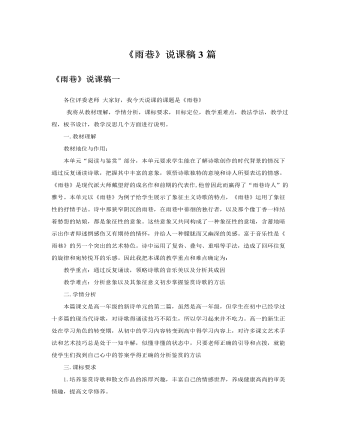
人教版高中语文必修1《雨巷》说课稿3篇
一.教材理解教材地位与作用:本单元“阅读与鉴赏”部分,本单元要求学生能在了解诗歌创作的时代背景的情况下通过反复诵读诗歌,把握其中丰富的意象,领悟诗歌独特的意境和诗人所要表达的情感。《雨巷》是现代派大师戴望舒的成名作和前期的代表作,他曾因此而赢得了“雨巷诗人”的雅号。本单元以《雨巷》为例子给学生展示了象征主义诗歌的特点,《雨巷》运用了象征性的抒情手法。诗中那狭窄阴沉的雨巷,在雨巷中徘徊的独行者,以及那个像丁香一样结着愁怨的姑娘,都是象征性的意象。这些意象又共同构成了一种象征性的意境,含蓄地暗示出作者即迷惘感伤又有期待的情怀,并给人一种朦胧而又幽深的美感。富于音乐性是《雨巷》的另一个突出的艺术特色。诗中运用了复沓、叠句、重唱等手法,造成了回环往复的旋律和宛转悦耳的乐感。因此我把本课的教学重点和难点确定为:教学重点:通过反复诵读,领略诗歌的音乐美以及分析其成因教学难点:分析意象以及其象征意义初步掌握鉴赏诗歌的方法
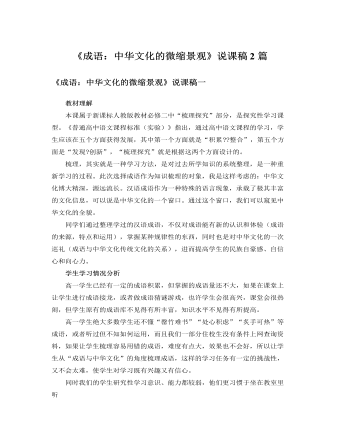
人教版高中语文必修2《赤壁赋》说课稿3篇
[教学反思]人教版高中语文必修二第三单元安排了《兰亭集序》《赤壁赋》《游褒禅山记》三篇古代山水游记散文,它们借游赏之事,探索生命的意义、治学的道理。师者,所以传道、授业、解惑也。高中的教材选用的都是历史经典名篇,每一篇都闪烁着儒道释等百家光辉的思想。编者要老师传道的意图很明显。即非如此,看着这些影响历代、影响世界的如日月之耀眼光华的伟大思想就躺在我们的教科书里,又如何能不讲呢?所以,我将本课的教学重难点拟定为:帮助学生建立积极的生死观,掌握多角度看问题的正确的思想方法。当然,也让学生领会了融写景、抒情、说理于一炉的大家手法。整堂课各教学环节,环环相扣,过渡自然,读、思、议、写训练到位,而且全部围绕“生死观”展开,如一篇形散神不散的散文。
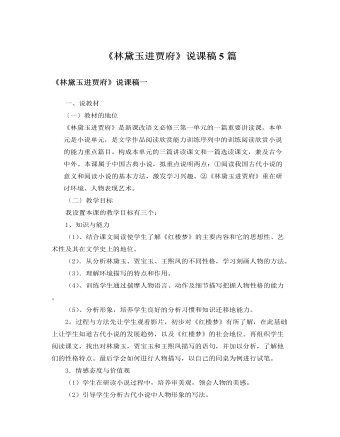
人教版高中语文必修3《林黛玉进贾府》说课稿5篇
【教学目标】我设置的本课的教学目标有三个:1、知识与技能(1)了解曹雪芹及《红楼梦》(2)学习通过一个人物的行踪、所见所闻,介绍典型环境,认识封建贵族阶级豪奢极耻的生活以及森严的等级、礼仪制度(3)分析小说人物出场的描写艺术,培养学生分析小说人物形象的能力。(4)一叶落而知秋”,通过对“林黛玉进贾府”这一故事情节的把握是否能引发对《红楼梦》的认知兴趣,并找到一个突破口,有针对性地进行自主探究,进而进行个性化解读。(5)整体认知小说,认识小说悲剧的必然性和思想价值.2、过程与方法(1)用直观演示和归纳探究法分析文章要点。(2)用讨论探究法体验作者对文中人物的情感态度。3、情感态度价值观(1)正确理解《红楼梦》的思想内涵,培养学生热爱祖国传统文化的思想感情。(2)认识封建大家族的腐朽没落,理解贾宝玉追求个性自由反封建的精神。
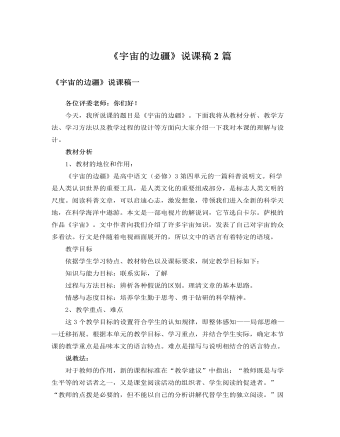
人教版高中语文必修3《宇宙的边疆》说课稿2篇
(有的恒星旋转平稳均衡,有些恒星是因快速旋转而变了形。作者以拟人的手法,生动形象地描述,仿佛向我们展示了不同恒星的性情:有的稳重沉静,有的急切躁动。读来生动有趣,妙趣横生。)(3)我们探索宇宙的时候,既要勇于怀疑,又要富于想象。想象经常能够把我们带领到崭新的世界,没有想象,我们就处处碰壁。怀疑可以使我们摆脱幻想,还可以检验我们的推测。(对于未知领域的探索是需要怀疑和想象的,想象是科学的翅膀,敢于想象,并不断地探索验证,所谓“大胆假设,小心求证”怀疑否定旧知,产生新知。作者以简洁的语言阐述了想象和怀疑看似矛盾的两者在宇宙探索中的相辅相成,和谐统一。作者不囿于介绍宇宙知识,还发表自己的见解。)(4)我认为宇宙里很可能到处都充满着生命,只是我们人类尚未发现而已。我们的探索才刚刚开始。

人教版高中英语必修2Computers说课稿3篇
一. 教材分析1. 本单元的中心话题是“计算机(Computers)”,内容涉及计算机的发展历史,计算机的应用等。本节课是该单元的第一课时,我将Warming up, Pre-reading and Comprehending这四部分整合为一节精读课。其中。Reading部分是题为WHO AM I?的文章,以第一人称的拟人手法介绍了计算机发长演变的历史和计算机在各个领域的应用,其主旨是表达计算机的发展变化之快以及在生活中用途之广。而Warming up部分以图片的形式展现了计算机的发展历程;Pre-reading中的问题和排序分别是为了预测语篇的内容和测试学生对计算机历史了解的情况;Comprehending则通过各项练习训练学生的阅读技能,从而加深对文章的理解。可见这几部分是一个有机的整体。2. 教学目标:1) 语言目标:重点词汇及短语:abacus, calculate, calculator, PC, laptop, PDA, robot, analytical, technological, universal, mathematical, artificial, intelligent, network, explore, in common, as a result.重点句子:a. My real father was Alan Turing, who in 1963 wrote a book to describe how computers could be made to work, and build a “universal machine” to solve any mathematical problem.

人教版高中英语必修2Wildlife Protection说课稿3篇
When it comes to the students’ studying methods, I'd like to introduce my Ss first. The Ss have a good command of basic language points. They’re interested in learning English, and they take an active part in English class, so they will have fun in autonomous, cooperative and inquiry learning. I will just serve as a guide, showing them the way to explore how to make more progress in their English learning.Now it’s time for the most important stage of this lesson. My teaching procedures are arranged as follows:Step1.Leading-in (3 minute)Play a video of a wide variety of wildlife to introduce my topic. Step2. Speaking (12 minutes)We will use our textbook Page25. Let the Ss fast read the short paragraph to warm up. Ask them to talk about the report on some endangered wildlife in China with the dialogue patterns on the screen. Lastly, I will invite some groups to demonstrate their dialogues about saving wildlife in China.Step3.English play (3 minutes)Watch another video in praise of their excellent performance just now. It’s about Jack Chen’s(成龙)and Yang Ziqiong’s wildlife protection.Step4. Listening (twice 13 minutes)This time, I’ll ask the Ss to fill in the blanks of the monologue of the 2 movie stars above. Step5.Discussion (3 minutes)Which would you like to choose to wear, clothes made of cotton, artificial leather or animal skins? Why ?Step6. Summary (3 minutes)1. If there were no wildlife, there wouldn’t exist human beings. If the buying stops, the killing can, too.2. Animals are our friends. To love animals is to love ourselves. Stop hunting, killing and destroying wildlife.3. Let’s live in harmony with all the living things in the world. Step7. Music appreciation (3 minutes)Let the Ss appreciate the song Earth Song by Michael Jackson. Last but not the least, I will show you my blackboard design.

人教版高中英语必修3Canada-the true north说课稿4篇
Good afternoon, teachers, It’s my great pleasure to be here sharing my lesson with you.The content of my lesson is Senior English Book 3 Unit 5 Canada —— “The true North”.I’ll be ready to begin this lesson from five parts. Analysis of the teaching material,the teaching methods,the studying methods, the teaching procedure,and Blackboard design.First, let me talk about the teaching material.Part 1 Teaching Material:This unit is about the introduction of Canada. By studying of this unit,we’ll enable the students to learn the geography, population, main cities, and natural beauty, natural resources of Canada. Through the training of the unit, it also requires students to learn some Language skills such as the expressions of position and emotions.So it plays an important part in the English teaching in this book.After studying the teaching material and analyzing the rule of children’s growing of mind,I think the teaching aims are the followings:1.Knowledge objects:(1) make the students learn some new words and phrases(2) make the students understand the content of the lesson.2.Ability objects:(1)To develop the Ss’ abilities of listening, speaking, reading and writing. Especially reading and speaking ability.(2) learn to talk about the characters of Canada in English(3)To train the Ss’ ability of working in pairs.3.Emotion objects:(1)Enable students to understand the characters of Canada..(2)Stimulate Ss to work hard to make China stronger.Part 2 Teaching Methods:I think helping students learn to master new words and phrases and improve the students’ reading and speaking ability is import and the difficult.According to the analysis of the teaching material and the import points and the difficult points,I will use the following teaching methods : question-guiding approach; fast-reading and careful reading; multi-media teaching methods; discussion

人教版高中英语必修4Theme parks说课稿3篇
The oldest and the most popular park in the worldenjoy the exciting activities thereget close to the life-size cartoon characters like Mickey Mouse and Donald Duck Step 3 Pre-reading1.What do you suppose a theme park is ?2.What do you think you can see in a theme park?(1.It is a kind of amusement park which has a certain theme – that the whole park is based on. 2.buildings, castles, statues, rare animals and birds, and so on.) Step 4 Reading ----- Theme Parks –---- Fun and More Than Fun1.Predict : Read the title and the pictures on P. 34 and PredictWhat is the meaning of the title “Theme Park – Fun and more than fun”?(The title means that theme parks are fun to visit, but that they can also be educational and can offer useful information.)2.Skimming Fast read and answer:What activities can we take in a theme park?Amusement park: Bumper car Merry-go-round slide bungee jumping Free-fall rides Horror films Pirate ship Ferris wheel roller coaster3.Scanning Read again and you will find various theme parks are mentioned in the passage . Then what are they ?Theme parks: Sports theme park History theme park Culture theme park Marine or Ocean theme Park Future park Science theme park Disneyland4.Careful reading and find the main idea of each paragraph:THEME PARKS---- entertaining/ educationalPara.1 Traditional parks are places to go for relaxation and to have time away from our busy lives.Para.2 Theme parks are different They’re large and full of things to do, see and buy.Para.3 Theme parks are built around a single idea or theme. One example is a sports park.Para.4 Another kind of theme park is historical more and cultural and can be educational.Para.5 Disneylandwas the first theme park. It is based on the fantasy life and characters of Disney’s films.Para.6 Some examples of educational theme parks include sea world parks and science parks.

人教版高中英语必修3Healthy Eating说课稿4篇
Language learning needs a context, which can help the learners to understand the language and then can product comprehensible output, so computer has the advantages to make the materials attractive.Part 3 Learning MethodsTask-based, self-dependent and cooperative learningPart 4 Teaching ProcedureStep One Lead-in“Interest is the best teacher.” Therefore, at the very beginning of the class, I should spark the students’ mind to focus on the centre topic “the band”. I’ll show some pictures of food to attract their attention and then bring some questions.Question:What kind of food they like?What should go into a good meal?The answers must relate to the diet. After this, the students will be eager to know something about a balance diet and this is the very time to naturally lead the class into Step 2Step 2 Reading for information: skimming and scanning In this step, I use Task-based Language Teaching method, which can give students a clear and specific purpose while skimming and scanning the context.Task 1 General ideaThe students will be asked to just glance at the title and the pictures of the passage, and then guess what they will read in the text. And they’ll be divided into groups of four to have a discussion.The purpose is to inspire the students to read actively, not passively. In addition, the task is to develop the students’ reading skill by making prediction and to encourage the students to express their thoughts in English and cooperate with each other.Task 2 Main idea of each paragraphCooperative learning can raise the students’ interest and create an atmosphere of achievement. Based on this theory, I divide the whole class into 4 groups to skim the whole text and get the main idea of each paragraph.
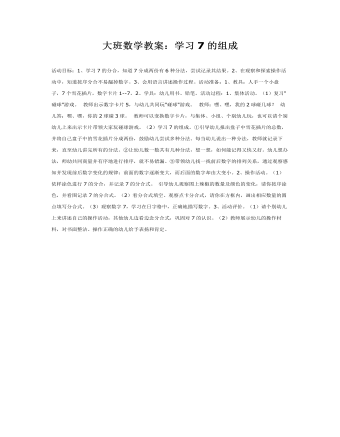
大班数学教案:学习7的组成
1、学习7的分合,知道7分成两份有6种分法,尝试记录其结果。2、在观察和探索操作活动中,知道按序分合不易漏掉数字。3、会用语言讲述操作过程。活动准备:1、教具:人手一个小盘子,7个雪花插片,数字卡片1--7。2、学具:幼儿用书、铅笔。活动过程:1、集体活动。(1)复习"碰球"游戏。 教师出示数字卡片5,与幼儿共同玩"碰球"游戏。 教师:嘿、嘿,我的2球碰几球? 幼儿答:嘿、嘿,你的2球碰3球。 教师可以变换数字卡片,与集体、小组、个别幼儿玩,也可以请个别幼儿上来出示卡片带领大家玩碰球游戏。(2)学习7的组成。①引导幼儿报出盘子中雪花插片的总数,并将自己盘子中的雪花插片分成两份,鼓励幼儿尝试多种分法。每当幼儿说出一种分法,教师就记录下来,直至幼儿讲完所有的分法。
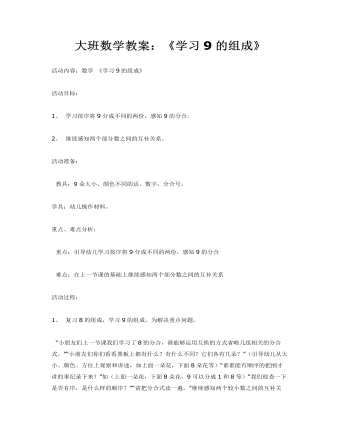
大班数学教案:《学习9的组成》
1、 学习按序将9分成不同的两份,感知9的分合。2、 继续感知两个部分数之间的互补关系。活动准备: 教具:9朵大小、颜色不同的话,数字,分合号。学具:幼儿操作材料。重点、难点分析: 重点:引导幼儿学习按序将9分成不同的两份,感知9的分合 难点:在上一节课的基础上继续感知两个部分数之间的互补关系
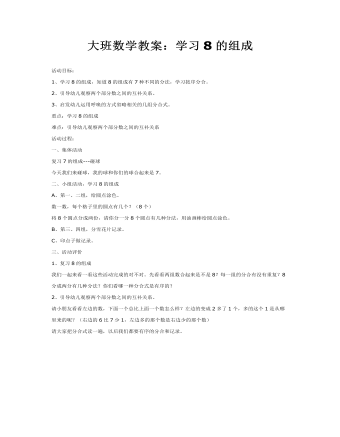
大班数学教案:学习8的组成
2、引导幼儿观察两个部分数之间的互补关系。3、启发幼儿运用呼唤的方式省略相关的几组分合式。重点:学习8的组成难点:引导幼儿观察两个部分数之间的互补关系活动过程:一、集体活动复习7的组成---碰球今天我们来碰球,我的球和你们的球合起来是7。

大班科学教案:少数民族
2. 主要从服装上尝试辨认蒙古族、藏族、维吾尔族、朝鲜族四个民族,了解他们的主要生活习惯及居住地。 3. 培养幼儿热爱少数民族的情感,进行爱国主义教育。 活动准备 1. 课前丰富有关地理知识与音乐舞蹈方面的技巧。 2. 自制投影片,中国地图,四个民族娃娃(彩色图片),居住地标记(蒙古包、大雪山等彩色图片大小各一套),彩色挂图,录音机。 活动过程 一、 开始部分 1. 出示中国地图,复习儿歌“中国地图”,巩固以前所学的地理知识。 2. 让幼儿知道中国是个多民族国家。 第一次尝试:中国是个多民族国家,请幼儿说一说知道有哪些民族,居住在地图上的什么位置? 幼儿讨论 3. 出示朝鲜、蒙古族、藏族、维吾尔族四个民族的娃娃,一起找出他们居住在“大公鸡”的什么地方,并将民娃娃与他们居住地的标记贴在地图上。
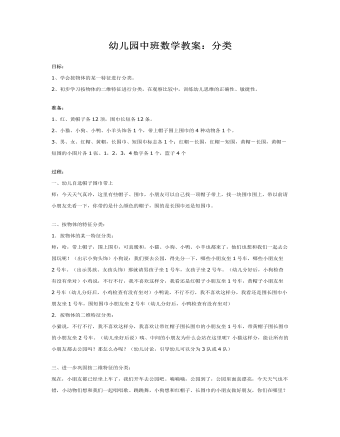
幼儿园中班数学教案:分类
准备: 1、红、黄帽子各12顶,围巾长短各12条。 2、小猫、小狗、小鸭、小羊头饰各1个,带上帽子围上围巾的4种动物各1个。 3、男、女、红帽、黄帽,长围巾、短围巾标志各1个;红帽-长围,红帽-短围,黄帽-长围,黄帽-短围的小图片各1张。1,2,3,4数字各1个,篮子4个过程: 一、幼儿自选帽子围巾带上 师:今天天气真冷,这里有些帽子、围巾,小朋友可以自己找一顶帽子带上,找一块围巾围上,带以前请小朋友先看一下,你带的是什么颜色的帽子,围的是长围巾还是短围巾。二、按物体的特征分类: 1.按物体的某一特征分类: 师:哈,带上帽子,围上围巾,可真暖和。小猫、小狗、小鸭、小羊也都来了,他们也想和我们一起去公园玩呢!(出示小狗头饰)小狗说:我们要去公园,得先分一下,哪些小朋友坐1号车,哪些小朋友坐2号车。(出示男孩、女孩头饰)那就请男孩子坐1号车,女孩子坐2号车。(幼儿分好后,小狗检查有没有坐对)小鸡说,不行不行,我不喜欢这样分,我看还是红帽子小朋友坐1号车,黄帽子小朋友坐2号车(幼儿分好后,小鸡检查有没有坐对)小鸭说,不行不行,我不喜欢这样分,我看还是围长围巾小朋友坐1号车,围短围巾小朋友坐2号车(幼儿分好后,小鸭检查有没有坐对)
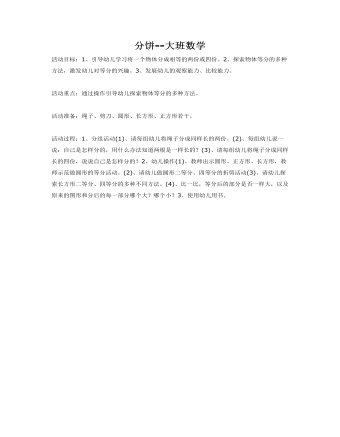
大班数学教案:分饼
方法,激发幼儿对等分的兴趣。3、发展幼儿的观察能力、比较能力。活动重点:通过操作引导幼儿探索物体等分的多种方法。活动准备:绳子、剪刀、圆形、长方形、正方形若干。
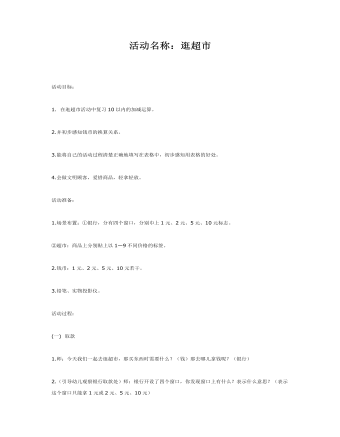
大班数学教案:逛超市
2.并初步感知钱币的换算关系。3.能将自己的活动过程清楚正确地填写在表格中,初步感知用表格的好处。4.会做文明顾客,爱惜商品,轻拿轻放。活动准备:1.场景布置:①银行,分有四个窗口,分别巾上1元、2元、5元、10元标志。②超市:商品上分别贴上以1—9不同价格的标签。2.钱币:1元、2元、5元、10元若干。3.铅笔、实物投影仪。
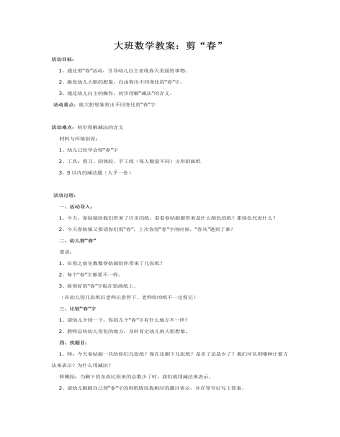
大班数学教案:剪“春”
活动重点:能大胆想象剪出不同变化的“春”字 活动难点:初步理解减法的含义 材料与环境创设: 1、幼儿已经学会剪“春”字 2、工具:剪刀、固体胶、手工纸(每人数量不同)方形铅画纸 3、5以内的减法题(人手一份) 活动过程: 一、活动导入: 1、今天,春姑娘给我们带来了许多的纸,看看春姑娘都带来是什么颜色的纸?那绿色代表什么? 2、今天春姑娘又要请你们剪“春”,上次你剪“春”字的时候,“春风”遇到了谁?
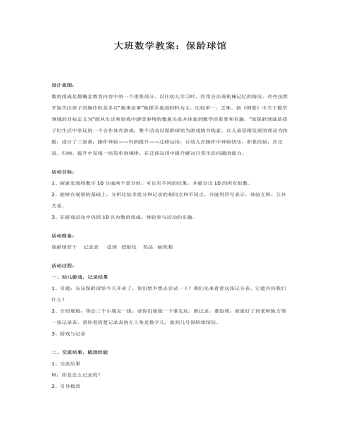
大班数学教案:保龄球馆
活动目标: 1、探索发现将数字10分成两个部分时,可以有不同的结果,并能分出10的所有组数。 2、能够在观察的基础上,分析比较多组分和记录的相同点和不同点,并能用符号表示,体验互换、互补关系。 3、在游戏活动中巩固10以内数的组成,体验参与活动的乐趣。 活动准备: 保龄球若干 记录表 皮球 投影仪 奖品 抽奖箱 活动过程:一、幼儿游戏,记录结果 1、引题:乐乐保龄球馆今天开业了,你们想不想去尝试一下?我们先来看看这张记分表,它能告诉我们什么? 2、介绍规则:等会三个小朋友一组,请你们商量一下谁先玩,谁记录,谁捡球,商量好了到老师地方领一张记录表,请你看清楚记录表的左上角是数字几,就到几号保龄球馆玩。 3、游戏与记录
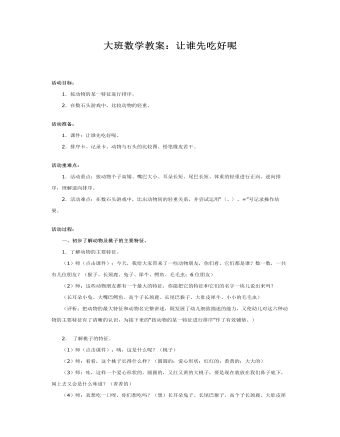
大班数学教案:让谁先吃好呢
活动准备:1.课件:让谁先吃好呢。2.排序卡、记录卡、动物与石头的比较图、铅笔橡皮若干。活动重难点:1.活动重点:按动物个子高矮、嘴巴大小、耳朵长短、尾巴长短、体重的轻重进行正向、逆向排序,理解逆向排序。2.活动难点:在数石头游戏中,比出动物间的轻重关系,并尝试运用“〈、〉、=”号记录操作结果。活动过程: 一、初步了解动物及桃子的主要特征。1.了解动物的主要特征。 (1)师(点击课件):今天,我给大家带来了一些动物朋友,你们看,它们都是谁?数一数,一共有几位朋友?(猴子、长颈鹿、兔子、犀牛、鳄鱼、毛毛虫;6位朋友) (2)师:这些动物朋友都有一个最大的特征,你能把它的特征和它们的名字一块儿说出来吗? (长耳朵小兔、大嘴巴鳄鱼、高个子长颈鹿、长尾巴猴子、大肚皮犀牛、小小的毛毛虫) (评析:把动物的最大特征和动物名完整讲述,既发展了幼儿细致描述的能力,又使幼儿对这六种动物的主要特征有了清晰的认识,为接下来的“按动物的某一特征进行排序”作了有效铺垫。)2.了解桃子的特征。 (1)师(点击课件):咦,这是什么呢?(桃子) (2)师:看看,这个桃子长得什么样?(圆圆的;爱心形状;红红的;黄黄的;大大的) (3)师:哇,这样一个爱心形状的、圆圆的,又红又黄的大桃子,要是现在就放在我们鼻子底下,闻上去又会是什么味道?(香香的) (4)师:真想吃一口呀,你们想吃吗?(想)长耳朵兔子、长尾巴猴子、高个子长颈鹿、大肚皮犀牛、大嘴巴鳄鱼、小小的毛毛虫和我们一样,看到这个桃子,馋得口水都快流出来了,都想先吃到这个大桃子。 (评析:对桃子形状、颜色、大小特征的讲述,以及对桃子气味的猜测,既“勾”起了幼儿品尝桃子的欲望,又“唤”起了他们对动物看到桃子后急切品尝心境的理解,适时、巧妙的引出了本次活动的一条暗藏线索“让谁先吃好呢?”。)二、按动物的某一特征排序。1.按动物高矮、大小、长短排序。 (1)按个子的高矮排序。A.师(点击课件):“按照个子的顺序吃怎么样?”长颈鹿把脖子挺得直直的,先说了一句。那就得先量量看,谁的个子最高了。毛毛虫说:“不能站在高的地方量,量的时候不能把尾巴算上”小兔说:“踮起脚来量也不行。”B.师(点击课件):瞧,他们每人都找了一棵大树开始量了起来。动物们和大树的什么比?(树干)C.师:它们一个个都紧贴着树干,认真的量着。小朋友,你们看出来了吗?谁最高?第二高是谁呢?第三高呢?接下来轮到谁?第五高?最矮的一个是谁呀?D.出示高矮排序图。E.讲述故事:“看见了吧?看见了吧?我的个子最高,所以得我先吃!”长颈鹿把脖子伸得长长的,刚要去咬那个又大又红的桃子。 (2)按嘴巴的大小排序。A.师(点击课件):“不行,这么大的桃子,当然得嘴巴最大的先吃了”鳄鱼张着一张大嘴,站了出来。到底谁的嘴巴最大?B.师(点击课件):“我的嘴巴大!”(犀牛声音)“谁说的!我的嘴巴才是最大的呢!”(鳄鱼声音)C.师:你们说,谁的嘴巴最大?(鳄鱼)E.讲述故事:“听见没,听见没有?我的嘴巴最大,当然是我先吃了!”鳄鱼使足了全身的劲儿,张大嘴巴,马上就要咬到这个又大又红的桃子了…… (3)按耳朵的长短排序。A.师(点击课件):“这么做不行!”蹦蹦跳跳的兔子竖着耳朵跑过来。B.师:欸,兔子会说什么呢?(谁耳朵长谁吃)C.师:那就是说得按什么顺序来吃桃子?(长短顺序)D.师:按什么的长短顺序,谁能完整的说一说?(按耳朵的长短顺序吃)E.师(点击课件):对,应该按照耳朵长短的顺序、谁的耳朵长谁先吃!那就比比,看看到底谁的耳朵最长吧。“看,还是我的耳朵最长吧!”小个子的兔子好不容易够到长颈鹿的脖子,说道。

大班数学教案:7的组成
2、通过讨论、分析,理解一个数分成两个部分,如一个不风增加1,另一个部分就要减少1。 活动准备 塑料小鸭学具人手42只。 活动过程 一、复习6的组成 玩“碰球游戏”,出现数咔,师问:这数是几?答“6”。师:今天玩碰游戏,教师与小朋友的数合起来是6。(例如),师:我的1球碰几球?答:你的1球碰5球)教师问,小朋友可集体回答,也可小组回答,也可个别回答。 二、集体尝试活动

